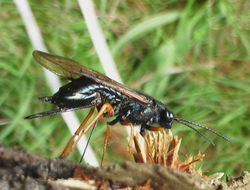Difference between revisions of "Sirex (genus)"
| Line 12: | Line 12: | ||
Type species: ''[[Sirex juvencus]]'' | Type species: ''[[Sirex juvencus]]'' | ||
| − | |||
| − | |||
Currently, the following species have been entered into the system: | Currently, the following species have been entered into the system: | ||
{{CategoryMembers|Sirex (genus)}} | {{CategoryMembers|Sirex (genus)}} | ||
Revision as of 15:52, 17 August 2018
| Literature database |
|---|
| 137 articles sorted by: |
| • year (recent ones first) |
| • research topics |
| • countries/regions |
| • host plants |
Sirex Linnaeus, 1761
The genus includes around 15 species of wood boring wasps which are found in temperate regions of the northern hemisphere. Sirex noctilio is native to Eurasia and northern Africa. It has been introduced into various other regions.
The female injects eggs, one at a time, into the wood of conifer trees, together with an endosymbiotic fungus of the genus Amylostereum. The fungus is transported in a special structure, the mycangium. It helps the digestion of the wood and provides other nutrients to the Sirex larvae. Typically each Sirex species specializes on a single genus of host trees.
The adults have a black or metallic bluish colour but some parts may be reddish brown. The genus is characterized by the presence of the fore wing vein Cu1.
Type species: Sirex juvencus
Currently, the following species have been entered into the system:
